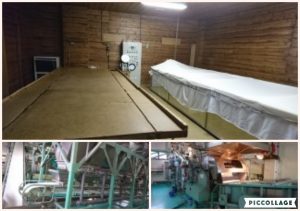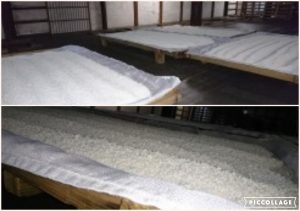BLOG
Rice and Koji
2018.02.22
I don’t want to bore you guys, so let’s try to get the most basic of chemistry out of the way as quickly as possible. Just remember this watered-down equation: Glucose + yeast = alcohol. That wasn’t too painful. You probably learned it in high school.
Keeping that in mind, most people outside of Japan are more familiar with wine and beer than they are with sake. Let’s take a look at them first. Wine is made from grapes. Grapes have a lot of glucose, therefore, with yeast, they can undergo a simple, one-step fermentation to create alcohol.
For drinks like sake and beer, which is made from a grain, there is another step required. This is because grains don’t have simple sugars. We address this problem with a process called “malting”. For sake, we apply a special mold called “koji” to our freshly steamed rice. Then, we leave it in a hot room for 3 days and let the koji work its magic. The koji mold turns the rice white and shiny. It has turned the starch in the rice into glucose. Now, the rice is ready for fermentation.
So how does the magic get started? We use a conveyor belt steamer to get our rice to just the right amount of water absorption. When it comes out of the steamer, it is really time-sensitive. We spread it out on a cloth to cool it off to a temperature where it can incorporate the koji most easily (on average, just under 30 degrees celcius). When it gets there, we can spread it out over a table in a hot room called Koji Muro. While it is spread out on this table, we will sprinkle the koji over the top and mix it in my hand. There, we will leave it for the next couple days, checking the temperature and progress regularly, and mixing the rice up to ensure consistent malting.

*While we use the conveyor belt and machine to wash most of our rice, we rinse and wash our Daiginjo rice by hand. This is because it is too small and delicate for machine-washing.
After the Koji rice has spent about 3 days in the Koji Muro, it will dry for one day. We spread it out over some trays and let it dry. Once it’s dry, it’s ready for making yeast starter mix.

Koji rice has an unmistakable, sweet aroma, and because of its pleasantness, it is used for other common Japanese foods like miso and amazake, as well as having benefit in cosmetic products.